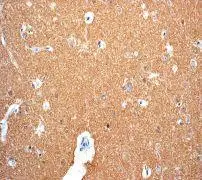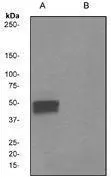
B. Immunohistochemical analysis of paraffin-embedded human brain tissue using Phospho-specific anti-Tau RabMAb (cat. # GTX62137).
Tau (phospho Ser198) antibody [EPR2400]
GTX62137
ApplicationsImmunoFluorescence, ImmunoPrecipitation, Western Blot, ImmunoCytoChemistry, ImmunoHistoChemistry, ImmunoHistoChemistry Paraffin
Product group Antibodies
ReactivityHuman
TargetMAPT
Overview
- SupplierGeneTex
- Product NameTau (phospho Ser198) antibody [EPR2400]
- Delivery Days Customer9
- Application Supplier NoteRecommended Starting Dilutions:For WB: Use at a dilution of 1:50,000 - 100,000For IHC: Use at a dilution of 1:100 - 250For ICC: Use at a dilution of 1:50 - 100For IP: Use at a dilution of 1:50Optimal working dilution for a specific application should be determined by the investigator.
- ApplicationsImmunoFluorescence, ImmunoPrecipitation, Western Blot, ImmunoCytoChemistry, ImmunoHistoChemistry, ImmunoHistoChemistry Paraffin
- CertificationResearch Use Only
- ClonalityMonoclonal
- Clone IDEPR2400
- ConjugateUnconjugated
- Gene ID4137
- Target nameMAPT
- Target descriptionmicrotubule associated protein tau
- Target synonymsDDPAC; FTDP-17; G protein beta1/gamma2 subunit-interacting factor 1; MAPTL; microtubule-associated protein tau; MSTD; MTBT1; MTBT2; neurofibrillary tangle protein; paired helical filament-tau; PHF-tau; PPND; PPP1R103; protein phosphatase 1, regulatory subunit 103; TAU; tau-40
- HostRabbit
- IsotypeIgG
- Protein IDP10636
- Protein NameMicrotubule-associated protein tau
- Scientific DescriptionThis gene encodes the microtubule-associated protein tau (MAPT) whose transcript undergoes complex, regulated alternative splicing, giving rise to several mRNA species. MAPT transcripts are differentially expressed in the nervous system, depending on stage of neuronal maturation and neuron type. MAPT gene mutations have been associated with several neurodegenerative disorders such as Alzheimers disease, Picks disease, frontotemporal dementia, cortico-basal degeneration and progressive supranuclear palsy. [provided by RefSeq, Jul 2008]
- ReactivityHuman
- Storage Instruction-20°C or -80°C,2°C to 8°C
- UNSPSC12352203

